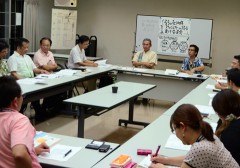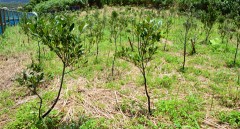Hundred-year tree-planting campaign started to make sanshin out of locally grown Kuroki

On June 25 at the Yomitan Village Culture Center, members of the executive committee discuss regulations at their first meeting.
July 16, 2012 Wakako Oshiro of Ryukyu Shimpo
Kuroki (kuruchi or Ryukyu kokutan) is an essential material for making the famous Okinawan musical instrument, the sanshin. To change the current situation that most kuroki are imported, “Kuruchi Forest 100 year Project in Yomitan” set off to plant kuroki in Okinawa. Kazufumi Miyazawa, a vocalist from The Boom known for their hit song, Shimauta, suggested this project. Using the profit from annual events and commemorative CD sales, the project offers a grand design for the planting of kuroki every year continuously for one hundred years. As the first event of the project, a concert will be held on October 20.
In the afternoon on 16th, the executive committee of the project and Miyazawa will have a press conference.
For three years since 2008, Nomura Ryu Koten Ongaku Hozonkai and Yomitan have planted 2500 kuroki trees in Zakimi Castle Park. With volunteers’ involvement, two projects became one and started in Yomitan. Their goal is in 2108 to be able to play sanshin made from locally grown kuroki.
On June 25 at the Village’s culture center, 20 volunteers gathered and held the first executive committee meeting. Miyazawa acted as honorary chairman and Mayor Denjitsu Ishimine was appointed as the chairman. Director of the Okinawa Prefecture Division of Culture, Tourism, and Sports, Daiichi Hirata became an advocate.
In the 20th year from the birth of the song Shimauta, Miyazawa suggested the kuroki as a tree- planting project to Hirata as Miyazawa’s repayment to Okinawa, which had contributed to his development. He is currently working with 100 supporting artists to make a commemorative CD.
Kuroki grows slowly taking several decades before it can be used as material to make sanshin. Materials taken from demolished houses are sometimes recycled, but most sanshin are made using wood imported from Taiwan and Vietnam.
(English translation by T&CT, Megumi Chibana and Mark Ealey)
Previous Article:New brand Kariyushi Style for ladies
Next Article:Collector acquires tickets and commuter passes of a street-car that operated in Okinawa in the prewar period
[Similar Articles]
- Miyazawa begins 100-year project planting kuroki for sanshin
- Kazufumi gives a lecture at Ryukyu University about producing Okinawan Kuruchi and avoiding war
- Audio CD of Shinkanucha, anthem of the 5th Worldwide Uchinanchu Festival sold
- Gifting project seeks sanshin donations to send to France
- Yomitan sets up executive committee for rally against suspected slaying of Okinawan woman by ex-US marine

 Webcam(Kokusai Street)
Webcam(Kokusai Street)


